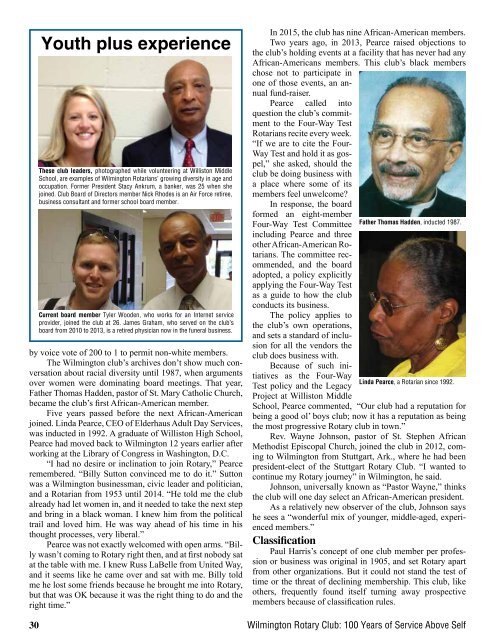Wilmington Rotary Club
Wilmington Rotary Club was establiished in 1915 and - 100 Year Anniversary of service above Self
Wilmington Rotary Club was establiished in 1915 and - 100 Year Anniversary of service above Self
You also want an ePaper? Increase the reach of your titles
YUMPU automatically turns print PDFs into web optimized ePapers that Google loves.
Youth plus experience<br />
These club leaders, photographed while volunteering at Williston Middle<br />
School, are examples of <strong>Wilmington</strong> Rotarians’ growing diversity in age and<br />
occupation. Former President Stacy Ankrum, a banker, was 25 when she<br />
joined. <strong>Club</strong> Board of Directors member Nick Rhodes is an Air Force retiree,<br />
business consultant and former school board member.<br />
Current board member Tyler Wooden, who works for an Internet service<br />
provider, joined the club at 26. James Graham, who served on the club’s<br />
board from 2010 to 2013, is a retired physician now in the funeral business.<br />
by voice vote of 200 to 1 to permit non-white members.<br />
The <strong>Wilmington</strong> club’s archives don’t show much conversation<br />
about racial diversity until 1987, when arguments<br />
over women were dominating board meetings. That year,<br />
Father Thomas Hadden, pastor of St. Mary Catholic Church,<br />
became the club’s first African-American member.<br />
Five years passed before the next African-American<br />
joined. Linda Pearce, CEO of Elderhaus Adult Day Services,<br />
was inducted in 1992. A graduate of Williston High School,<br />
Pearce had moved back to <strong>Wilmington</strong> 12 years earlier after<br />
working at the Library of Congress in Washington, D.C.<br />
“I had no desire or inclination to join <strong>Rotary</strong>,” Pearce<br />
remembered. “Billy Sutton convinced me to do it.” Sutton<br />
was a <strong>Wilmington</strong> businessman, civic leader and politician,<br />
and a Rotarian from 1953 until 2014. “He told me the club<br />
already had let women in, and it needed to take the next step<br />
and bring in a black woman. I knew him from the political<br />
trail and loved him. He was way ahead of his time in his<br />
thought processes, very liberal.”<br />
Pearce was not exactly welcomed with open arms. “Billy<br />
wasn’t coming to <strong>Rotary</strong> right then, and at first nobody sat<br />
at the table with me. I knew Russ LaBelle from United Way,<br />
and it seems like he came over and sat with me. Billy told<br />
me he lost some friends because he brought me into <strong>Rotary</strong>,<br />
but that was OK because it was the right thing to do and the<br />
right time.”<br />
In 2015, the club has nine African-American members.<br />
Two years ago, in 2013, Pearce raised objections to<br />
the club’s holding events at a facility that has never had any<br />
African-Americans members. This club’s black members<br />
chose not to participate in<br />
one of those events, an annual<br />
fund-raiser.<br />
Pearce called into<br />
question the club’s commitment<br />
to the Four-Way Test<br />
Rotarians recite every week.<br />
“If we are to cite the Four-<br />
Way Test and hold it as gospel,”<br />
she asked, should the<br />
club be doing business with<br />
a place where some of its<br />
members feel unwelcome?<br />
In response, the board<br />
formed an eight-member<br />
Four-Way Test Committee<br />
including Pearce and three<br />
other African-American Rotarians.<br />
The committee recommended,<br />
and the board<br />
adopted, a policy explicitly<br />
applying the Four-Way Test<br />
as a guide to how the club<br />
conducts its business.<br />
The policy applies to<br />
the club’s own operations,<br />
and sets a standard of inclusion<br />
for all the vendors the<br />
club does business with.<br />
Because of such initiatives<br />
as the Four-Way<br />
Test policy and the Legacy<br />
Project at Williston Middle<br />
Father Thomas Hadden, inducted 1987.<br />
Linda Pearce, a Rotarian since 1992.<br />
School, Pearce commented, “Our club had a reputation for<br />
being a good ol’ boys club; now it has a reputation as being<br />
the most progressive <strong>Rotary</strong> club in town.”<br />
Rev. Wayne Johnson, pastor of St. Stephen African<br />
Methodist Episcopal Church, joined the club in 2012, coming<br />
to <strong>Wilmington</strong> from Stuttgart, Ark., where he had been<br />
president-elect of the Stuttgart <strong>Rotary</strong> <strong>Club</strong>. “I wanted to<br />
continue my <strong>Rotary</strong> journey” in <strong>Wilmington</strong>, he said.<br />
Johnson, universally known as “Pastor Wayne,” thinks<br />
the club will one day select an African-American president.<br />
As a relatively new observer of the club, Johnson says<br />
he sees a “wonderful mix of younger, middle-aged, experienced<br />
members.”<br />
Classification<br />
Paul Harris’s concept of one club member per profession<br />
or business was original in 1905, and set <strong>Rotary</strong> apart<br />
from other organizations. But it could not stand the test of<br />
time or the threat of declining membership. This club, like<br />
others, frequently found itself turning away prospective<br />
members because of classification rules.<br />
30 <strong>Wilmington</strong> <strong>Rotary</strong> <strong>Club</strong>: 100 Years of Service Above Self



